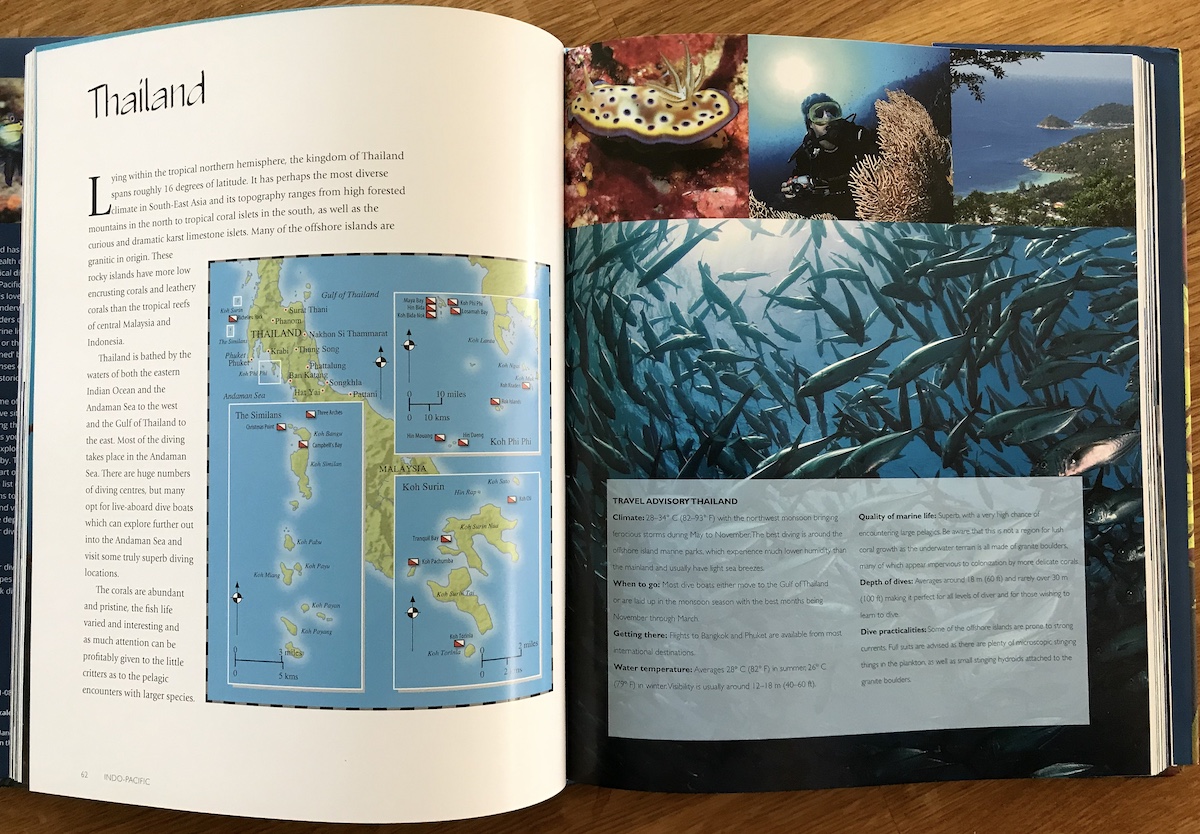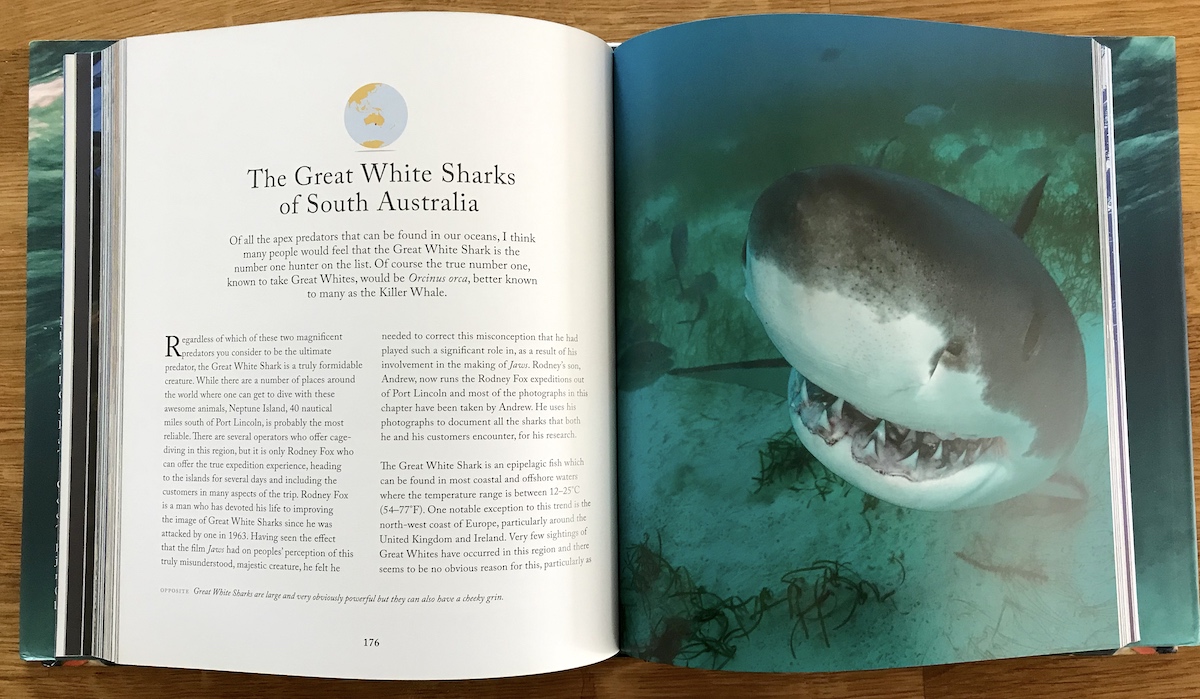Welcome to Part Three of this virtual tour through the worlds’ dive sites courtesy of a half-dozen of the best books on the subject available today. This concludes this series but undoubtedly there will be others because I just can’t stop buying dive books!
Part One can be found here and Part Two here. Enjoy!
 The World’s Great Dive Sites – Lawson Wood
The World’s Great Dive Sites – Lawson Wood
The title is a bit of a misnomer as this book only covers tropical diving, this is due to it being effectively a re-branding of Lawson Woods’ 2014 ‘The World’s Best Tropical Dive Destinations’. I guess implying it covered the whole world would sell more?
If you’re a diver you’ve likely already come across Lawson Wood whether through articles in most of the main diving magazines or as the author or co-author of one or more of over 45 books covering both UK & warm-water locations. He is also a founding member of the Marine Conservation Society.
 The 270-plus sites covered are set out by sea / ocean: Red Sea, Indian Ocean, Indo-Pacific, Pacific, Caribbean (no sign of the Atlantic & hence as mentioned no cold-water coverage). In each section you get a brief overall introduction & then for each of the different areas (such as the Philippines, Papua New Guinea etc. within the ocean/sea you get a further overview (including high level maps) & ‘Travel Advisory’ (climate, when to go, getting there, water temperature, life & practicalities (currents/gear) & then 10 or so pages focus on the sites within those areas. Maps inside the front & back covers provide a zoomed out view of the various areas covered by the book.
The 270-plus sites covered are set out by sea / ocean: Red Sea, Indian Ocean, Indo-Pacific, Pacific, Caribbean (no sign of the Atlantic & hence as mentioned no cold-water coverage). In each section you get a brief overall introduction & then for each of the different areas (such as the Philippines, Papua New Guinea etc. within the ocean/sea you get a further overview (including high level maps) & ‘Travel Advisory’ (climate, when to go, getting there, water temperature, life & practicalities (currents/gear) & then 10 or so pages focus on the sites within those areas. Maps inside the front & back covers provide a zoomed out view of the various areas covered by the book.
Lawsons’ experience & passion come across very clearly in the text which besides detailing each of the selected dives (with type, depth, current & highlights to look out for) is brilliantly supplemented & brought to life with no shortage of stunning photographs of the locations both above and below water. (over 230 of them). Subjects include reefs, wrecks, macro & micro life many presented full or half-page in exquisite colour.

The second largest of the books on offer here & honestly when you are trying to get across the majesty of what you can see under the water size really does matter! Worth the money ? I’d say yes, with the caveat that you understand you’re only getting the warm-water half of the story.
(£25. 208pp. 20.3 x 25.4 x 2.3 (cm). Hardback. John Beaufoy Publishing Ltd. Sep 2019. ISBN10:1912081083)
 World’s Best Wildlife Dive Sites – Caroline Robertson-Brown & Nick Robertson-Brown
World’s Best Wildlife Dive Sites – Caroline Robertson-Brown & Nick Robertson-Brown
This one doesn’t get much of a mention in the various bestseller/top10 lists you see paraded around the place & indeed I only came across it by accident during one of the google searches for items for this article. Is that because it isn’t any good? Let’s find out…
Size-wise this one is mid-range in this group & the slightly larger format than some of the others certainly helps the excellent photos to shine.
Rather than being various ‘experts’ selection based on the dives themselves this book sets the wildlife front & centre with selection on the basis of the wildlife that visitors can expect to see which, over the 27 articles ranges from the Frogfish of Lembeh Strait to the Manatees of Crystal River and the Devil Rays of the Azores to the Swimming Pigs of the Exumas islands!
It’s really nice, amongst all the other books we’ve looked at, many of which have a big focus on warm-water to find another book that devotes a reasonable page count to less temperate zones! The UK gets 24 pages with a focus on basking sharks off the Isle of Man, seals in the Farne Islands and Blue Sharks off Cornwall – all available to UK divers without a plane ride in sight!
 Divided up by continent (Africa, Europe, Asia, Australasia & the Americas if geography wasn’t your strong suit) , each chapter summarises the key species, the best times of year, practical tips for visitors (such as limitations on access to some sites), equipment to take (wetsuits, boots etc. as appropriate) and alternative sites where you might find similar environments and species – see the illustration for Bimini to the right.
Divided up by continent (Africa, Europe, Asia, Australasia & the Americas if geography wasn’t your strong suit) , each chapter summarises the key species, the best times of year, practical tips for visitors (such as limitations on access to some sites), equipment to take (wetsuits, boots etc. as appropriate) and alternative sites where you might find similar environments and species – see the illustration for Bimini to the right.
Nick & Caroline clearly know their stuff (with qualifications in the Natural Sciences as well as being award-winning photographers & running their own photography business) and the articles for each type of creature provide clear background history & detail about the species and its habits and lifecycle as well as tips on where & when to see them at their best. The fact they have been diving these sites together for 25 years and have a conservation-driven focus to protect them comes through very clearly. Their pedigree as previously mentioned in the photography realm shines through in the accompanying photographs which do an excellent job at bringing the undersea world to vibrant life. My bucket list of places to visit has certainly grown since reading this book.
The books’ introduction provides an insight the steps the couple had to go through to deliver the book in the 12 months they were given to complete it. Though they already had thousands of images from their photography business they opted to ensure the illustrations they provided reflected the current position & planned out a hectic schedule (that they admit any diver would jump at the chance for), in some cases they had to supplement the images with others provided by friends when nature didn’t play ball.
But the effort paid off & resulted in this handsome volume, get it to learn things about sites you’ve already visited or start the listing of those you’d like to visit next!

Another thumbs up for me on this one, the very different approach of coverage by wildlife rather than area is refreshing & nearly 300 pages for £20 is a bargain. Add it to the list!
(£19.99. 288pp. 20.7 x 23.7 x 2.6 (cm), Hardback. New Holland Publishers. May 2016. ISBN10:1921517727)


